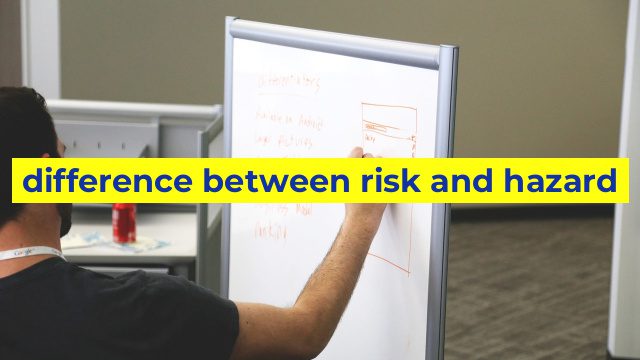The Difference Between Risk and Hazard: Understanding the Importance for Workplace Safety
When it comes to workplace safety, it’s essential to understand the difference between risk and hazard. While they may seem similar, these two terms are distinct and require different approaches for minimizing workplace accidents and injuries.
What is a Hazard?
A hazard is any equipment, substance, process, or situation that can cause harm or damage to people, property or the environment. Hazards can be classified into several categories, including biological, chemical, physical, and ergonomic.
Examples of hazards in the workplace include hazardous chemicals, electrical equipment, traffic or moving machinery, slippery surfaces, loud noise, poor lighting, poor ergonomics, fire and explosion risk, and more. Hazards can also be natural, such as weather events, geological hazards, or animal attacks.
What is Risk?
Risk refers to the likelihood and severity of harm that can result from exposure to a hazardous situation or substance. Risk can be calculated based on the likelihood and severity of an event occurring, as well as the number and type of workers exposed to the hazard.
Risk can also be classified as low or high, depending on the likelihood and severity of the potential harm. Low-risk hazards may result in minor injuries, while high-risk hazards can cause serious injury or death to workers.
The Importance of Understanding the Difference between Hazard and Risk
Understanding the difference between hazard and risk is critical for workplace safety. Hazards can be identified, assessed, and controlled or eliminated to reduce the risk of accidents and injuries in the workplace.
It is also important to prioritize hazards and risks based on their severity and likelihood of occurrence, focusing first on high-risk hazards that pose an immediate danger to workers. Regular hazard and risk assessments should be conducted, and appropriate preventative measures implemented and communicated to all workers to avoid accidents and injuries.
Conclusion
In summary, hazards are potential sources of harm, while risk is the likelihood and severity of harm arising from exposure to a hazard. Proper identification, assessment, and management of hazards and risks are essential for maintaining a safe and healthy workplace and reducing the risk of workplace accidents and injuries.
By implementing effective strategies for hazard identification, risk assessment, and control, both employers and employees can ensure a safer and healthier working environment for all.
Table difference between risk and hazard
| Characteristic | Risk | Hazard |
|---|---|---|
| Definition | Probability or chance of loss or damage from a potential danger | Potential source of harm or danger that can cause injury, illness, or damage |
| Focus | Emphasizes the likelihood of a particular outcome | Emphasizes the potential harm that exists |
| Examples | Financial risk, security risk, reputational risk | Chemical hazards, physical hazards, biological hazards |
| Management strategies | Risk assessment, risk avoidance, risk mitigation, risk transfer | Hazard identification, hazard evaluation, hazard control, hazard communication |
| Assessment | Involves both the probability of a negative outcome and the severity of that outcome | Involves identifying and evaluating the potential for harm and the associated risks |

